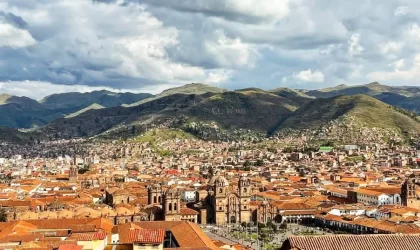CORPUS CHRISTI IN CUSCO – 2024: A RELIGIOUS CELEBRATION IMPREGNATED WITH TRADITION AND DEVOTION
Corpus Christi in Cusco – 2024: A Religious Celebration Steeped in Tradition and Devotion
Every year, the city of Cusco, in the heart of the Peruvian Andes, is immersed in a unique and vibrant atmosphere during the celebration of Corpus Christi. This festival, which blends elements of Catholicism with the region’s rich cultural heritage, attracts both locals and visitors alike. Corpus Christi in Cusco has become an iconic event that highlights the deep connection between faith, history, and the identity of this ancient city.
Origins of Corpus Christi in Cusco:
The Corpus Christi festival in Cusco dates back to the 13th century when the Catholic Church established the celebration to honor the body and blood of Christ in the Eucharist. In Cusco, this tradition merged with indigenous customs, resulting in a unique celebration that reflects the region’s cultural diversity.
The Solemn Procession:
The highlight of Corpus Christi in Cusco is the procession that winds through the city’s cobblestone streets. This procession, marked by the presence of elaborately decorated platforms and religious figures, showcases the devotion of the Cusco community. Each saint and virgin is accompanied by musicians, dancers, and devotees dressed in traditional clothing, creating a one-of-a-kind visual and auditory experience.
Below, we share the curious and humanized stories of the Saints and Virgins:
Saint Anthony the Abbot: He is known for his emblem of a piglet. It is said that before entering the Cathedral, he visits Saint Peter, and during their conversation, his piglet goes missing, causing an anxious scare, only to be found in the central market.
Saint Jerome: He carries a lion on his left side, which, during the procession, tries to break away because it wants to eat Saint Anthony’s piglet. Saint Jerome leaves his parish at dawn to race Saint Sebastian to see who reaches the Cathedral first. Saint Sebastian waits for him on Avenida de la Cultura.
Saint Christopher: Said to be one of the most attractive saints, with a robust physique, he draws a lot of attention during the procession. It’s told that he enjoys chicha de jora (fermented corn beer) and sneaks away to the Santa Ana neighborhood to sample this traditional drink. It’s also said that in one of his drunken moments, while crossing the Saphy River, he realized he was carrying the wrong child instead of baby Jesus.
Saint Sebastian: Known as “calapatita” (barefoot), his carriers shoulder him with bare feet from his parish. He is also said to have been a cavalryman in the Christian wars, having died by an arrow while tied to a tree.
Saint Barbara: Legend has it that she was a princess who was overprotected by her father, who didn’t allow men to court her and locked her in a tower. Her sorrow was so great that she cried, causing a storm with lightning that set fire to the tower she was imprisoned in.
Saint Anne: She is said to have a close friendship with Saint Christopher due to her excellent chicha de jora preparation skills. Also known as “The Patroness of the Picanterías” (traditional food stalls), she is often upset in the days leading up to Corpus Christi, wondering, “Who drank the chicha de jora I prepared?” She suspects it was Saint Christopher, exclaiming, “Who drank my chicha, and didn’t even leave a drop!”
Saint James the Apostle: Known as the “Moor-slayer” patron, it is said that he and Saint Sebastian were friends, having fought in the Christian wars together. Saint James belonged to the infantry. Legend tells that one day, Saint James borrowed Saint Sebastian’s horse, promising to return it, but was unable to because Saint Sebastian died by an arrow.
There’s also an interesting fact: it is said that the Saints and Virgins participating in Corpus Christi don’t want Saint James to enter the Cathedral because he causes too much disorder inside.
Saint Blaise: His devotees say that the index and middle fingers of his right hand allude to “two more chichas, and we’ll leave.” They also joke that the altar boys with him say, “Two are my sons, but who knows about the others.”
Saint Peter: The closest to Jesus, he is responsible for bringing both good and bad news to everyone gathered in the Cathedral during the days leading up to Corpus Christi. He usually shares the news in an entertaining manner in front of the Lord of the Earthquakes.
Saint Joseph: Known for his jealousy, Saint Joseph is often upset because the Virgin of Bethlehem is admired for her jewels and coquettish face by Saint Christopher and Saint James. His jealousy runs so deep that he sends the child Jesus to strike an intrusive Saint Blaise with his staff.
The Virgin of the Nativity: Known as “Nati,” she is said to be the humblest and is often mocked by the Virgin of Bethlehem for her lack of luxury. During the procession, Bethlehem looks at her scornfully, saying, “Look at this nanny,” to which Nati replies, “I may be a nanny, but an honest one.”
The Virgin of Remedies: She carries three small children, who show great joy, by her sides and on her back. It is said that those desiring to have children can pray to her, and she may grant the miracle despite infertility.
The Virgin of the Purification: Known as “the millionaire” for her many jewels, she carries two turtle doves in a basket as a symbol of “purification.” She is said to enjoy beer, as no celebration is complete without it.
The Virgin of Bethlehem: Known as the Patroness of Cusco, she is said to be the most vain of all the Virgins, admired for her coquettish face and adorned with jewels from head to toe. She is also famous for preparing a delicious chiriuchu (traditional dish).
The Virgin of the Immaculate Conception: Known as “The Beauty of the Cathedral,” she is considered the hostess of her sanctuary. Though described as modest, it is said that she sneaks out to visit her friends, including the Virgin of Remedies, also known as the patroness of the Archdiocese of Cusco.



